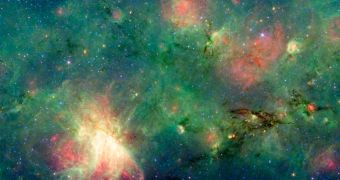Astronomers using the NASA Spitzer Space Telescope identified a peculiar structure lurking within the M17 nebula. Called M17 SWex, the formation is a dark dust cloud, which is apparently forming new stars at a frantic pace. Still, it has not yet produced O stars, the largest of them all.
Observing this cloud would have been impossible without using Spitzer. The observatory conducts its investigations in infrared wavelengths, which can penetrate through thick layers of cosmic dust and hydrogen gas.
At these wavelengths, the NASA telescope can detect the heat created by young, blue stars being formed inside their protective dust cocoons. The cloud that was recently photographed is visible in the central-right portion of the attached image.
According to experts, M17 Swex is forming stars at an incredibly-high rate, but it has yet to start producing O-class stars, the largest celestial fireballs ever seen in the Universe, Daily Galaxy reports.
Bodies of this type can also be seen in the image, but they are located outside the dark cloud and to its left, toward the central area of this view. Their radiation causes the dust around to glow brightly in infrared, experts say.
“We believe we've managed to observe this dark cloud in a very early phase of star formation before its most massive stars have ignited,” says astronomer Matthew Povich.
The expert, who holds an appointment at the Pennsylvania State University, is also a postdoctoral fellow, and the lead author of the new work. The study appears in a recent issue of the esteemed scientific publication The Astrophysical Journal Letters.
Scientists hope to use the new observations to gain more insight into why and how the most massive stars in the Universe develop.
“Most of the stars we've detected are relatively bright. So we predict the actual number of stars forming in M17 SWex is over 10,000, since the fainter stars cannot be detected with the current observations,” the Penn State astronomer adds.
“The time-sequence of star formation proceeds in the same direction that a spiral arm crosses the M17 cloud complex,” the expert goes on to say.
“The M17 region brings to mind images of other spiral galaxies where the leading edges of the arms appear blue, with young O stars, but the trailing edges are still dark, with obscuring dust like in M17 Swex,” he concludes.

 14 DAY TRIAL //
14 DAY TRIAL //